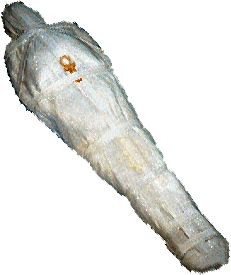
Local Crafts
Royal Tomb
Royal Tomb
Negotiating the northern tombs with help
Tomb of Ay
Northern tomb
Northern Tomb
Northern or Nefertiti Palace
Aton temple

Boundary Stele

Petosiris
Petosiris






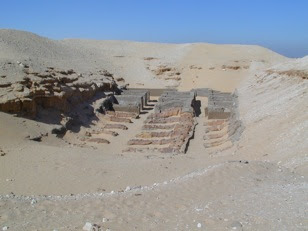









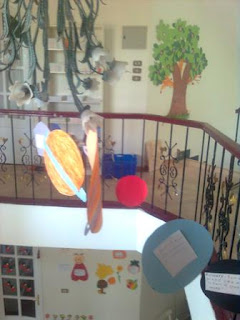




 and architectural monuments that continue to astound the modern world, Egypt has a unique and varied history. Given its unstable present and uncertain future, it is understandable that one might consider the wonders of Egypt’s earlier days with curiosity, and even a little envy. For those who have ever wondered what life was like when the Egyptian empire was the heart of the civilized world, some answers can be found in Donald P. Ryan’s book, Egypt 1250 BC: A Traveler's Companion.
and architectural monuments that continue to astound the modern world, Egypt has a unique and varied history. Given its unstable present and uncertain future, it is understandable that one might consider the wonders of Egypt’s earlier days with curiosity, and even a little envy. For those who have ever wondered what life was like when the Egyptian empire was the heart of the civilized world, some answers can be found in Donald P. Ryan’s book, Egypt 1250 BC: A Traveler's Companion.What Is Mummification?
Mummification is the preservation of a body, either animal or human. Some mummies are preserved wet, some are frozen, and some are dried. It can be a natural process or it may be deliberately achieved. The Egyptian mummies were deliberately made by drying the body. By eliminating moisture, you have eliminated the source of decay. They dried the body by using a salt mixture called natron. Natron is a natural substance that is found in abundance along the Nile river. Natron is made up of four salts: sodium carbonate, sodium bicarbonate, sodium chloride, and sodium sulfate. The sodium carbonate works as a drying agent, drawing the water out of the body. At the same time the bicarbonate, when subjected to moisture, increases the pH that creates a hostile environment for bacteria. The Egyptian climate lent itself well to the mummification process, being both very hot and dry.
Why Did The Ancient Egyptian's Mummify Their Dead?
The Egyptians believed that there were six important aspects that made up a human being: the physical body, shadow, name, ka (spirit), ba (personality), and the akh (immortality). Each one of these elements played an important role in the well being of an individual. Each was necessary to achieve rebirth into the afterlife.
With the exception of the akh, all these elements join a person at birth. A person's shadow was always present. A person could not exist with out a shadow, nor the shadow without the person. The shadow was represented as a small human figure painted completely black.
A person's name was given to them at birth and would live for as long as that name was spoken. This is why efforts were made to protect the name. A cartouche (magical rope) was used to surround the name and protect it for eternity.
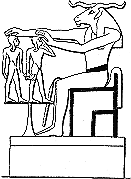 The ka was a person's double. It is what we would call a spirit or a soul. The ka was created at the same time as the physical body. The doubles were made on a potters wheel by the ram-headed god, Khnum. The ka existed in the physical world and resided in the tomb. It had the same needs that the person had in life, which was to eat, drink, etc. The Egyptians left offerings of food, drink, and worldly possessions in tombs for the ka to use.
The ka was a person's double. It is what we would call a spirit or a soul. The ka was created at the same time as the physical body. The doubles were made on a potters wheel by the ram-headed god, Khnum. The ka existed in the physical world and resided in the tomb. It had the same needs that the person had in life, which was to eat, drink, etc. The Egyptians left offerings of food, drink, and worldly possessions in tombs for the ka to use.
The ba can best be described as someone's personality. Like a person's body, each ba was an individual. It entered a person's body with the breath of life and it left at the time of death. It moved freely between the underworld and the physical world. The ba had the ability to take on different forms.
The akh was the aspect of a person that would join the gods in the underworld being immortal and unchangeable. It was created after death by the use of funerary text and spells, designed to bring forth an akh. Once this was achieved that individual was assured of not "dying a second time" a death that would mean the end of one's existence.
An intact body was an integral part of a person's afterlife. Without a physical body there was no shadow, no name, no ka, ba, or akh. By mummification, the Egyptians believed they were assuring themselves a successful rebirth into the afterlife.
From May 21, to June 25, 1994 A.D. a team of scientists from The University of Maryland and The Long Island University performed the first human mummification in nearly 2,000 years. They used replicas of ancient Egyptian embalming tools, one hundred yards of fine Egyptian linen, more than 600 pounds of natron, frankincense and myrrh, oil of cedar, palm wine, and natural resins. The mummification was preformed at The University of Maryland Medical School in Baltimore, MD.
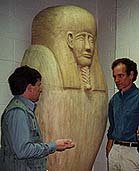 The two men responsible for this giant leap back in time are Ronn Wade (left), the Director of Anatomical Services at the University of Maryland Medical School in Baltimore; Bob Brier (right), an Egyptologist at the C. W. Post Campus of Long Island University. Their mummy is called Mumab. According to Ronn, Mumab has been tested before and during the mummification and will continue to tested in an effort to create a baseline against which all mummies can be scrutinized. Unlike ancient mummies, this one has a medical history, past, present, and future. Let's take a look at what they have accomplished and learned from Mumab.
The two men responsible for this giant leap back in time are Ronn Wade (left), the Director of Anatomical Services at the University of Maryland Medical School in Baltimore; Bob Brier (right), an Egyptologist at the C. W. Post Campus of Long Island University. Their mummy is called Mumab. According to Ronn, Mumab has been tested before and during the mummification and will continue to tested in an effort to create a baseline against which all mummies can be scrutinized. Unlike ancient mummies, this one has a medical history, past, present, and future. Let's take a look at what they have accomplished and learned from Mumab.
For some time Ronn and Bob had been searching for a suitable donor. They had a list of requirements that had to be fulfilled. They were looking for an average human specimen, someone they could compare to the average Egyptian. It had to be someone who had donated their body to science and was available for a very long, long-term project. It had to be someone whom had never had a major disease and never had an operation. Death must have occur from natural causes, but it did not matter if it was a man or a woman. As luck would have it, it was an elderly man from Baltimore who died from heart failure. The ancient Egyptian mummification process took 70 days. After that this elderly Baltimore man would be Mumab.
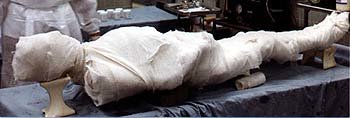
In light of all that the Ancient Egyptians have told us in countless text and paintings about almost every aspect of their civilization, It is strange that they left such gaping holes in our knowledge. For instance, we know very little of how the pyramids were constructed, or how obelisks were raised. Like these mysteries, the ancient Egyptians have told us nothing about the mummification process. Perhaps it was considered so sacred that it was only past on verbally to those considered worthy of the knowledge.
One written record concerning mummification to have survived comes from the Greek historian Herodotus, who visited Egypt around 450 BC. He described how the Egyptians preserved their dead. But even with the help of Herodotus, many questions remain. Much of Herodotus' account of the process is sketchy and open to speculation. For example, how the Egyptians used natron to dry the body has been a controversy ever since early Egyptologists translated the text of Herodotus. Some translated it to mean that the body was "pickled" in a natron solution. This technique would require large vats to soak the corpses in, no evidence to support this theory has ever been found. Instead, there is evidence of large tables being used for the drying process. But it has never been clear why these tables are nearly six feet across, wide enough to fit two corpses. These and many more questions were answered during the mummification of Mumab.


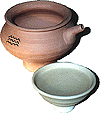 The first step in putting together a modern mummy was to gather the tools and ingredients that would be needed for the process. A silversmith made replicas of Egyptian embalming tools (above). A master carpenter was enlisted to construct an authentic embalming table, similar to one found in an Egyptian tomb. The ceramics department of Long Island University was commissioned to make all the vessels needed for the process. Each marked with hieroglyphs to denote its function. That department also made the canopic jars and 365 ushabtis (left) one spiritual worker for each day of the year.
The first step in putting together a modern mummy was to gather the tools and ingredients that would be needed for the process. A silversmith made replicas of Egyptian embalming tools (above). A master carpenter was enlisted to construct an authentic embalming table, similar to one found in an Egyptian tomb. The ceramics department of Long Island University was commissioned to make all the vessels needed for the process. Each marked with hieroglyphs to denote its function. That department also made the canopic jars and 365 ushabtis (left) one spiritual worker for each day of the year.
A trip to Egypt was necessary to collect the spices and oils that would be used. Bob went to the Wadi Natrun district between Cairo and Alexandria to collect the more then 600 pounds (270 kilograms) of natron that would be needed. Here, the Nile river feeds several lakes that rise and recede during the course of each year, leaving large salt deposits along the shore. This natron would be used to dry the body. According to Ronn, "Natron works by getting water out of the tissue, if you don't have water, you don't have decay."
It was time to begin. Ronn and Bob brought the elderly Baltimore man to his ibu the "tent of purification," which in this case was a room at the School of Medicine in Baltimore. Here, the body was washed with a solution of natron and water. In order to dry the body completely, the internal organs must be removed.
The first organ removed was the brain. The Egyptians believed that the brain was of little importance and it was thrown away when removed. Once again we use Herodotus' account for guidance. He states that the brain was extracted by poking a hole in the thin bone at the top of the nostrils, the ethmoid bone. ![]() A large bronze needle with a hooked or spiral end was used to perform this procedure. However, it has never been clear how such a large organ was removed through such a small hole. It had been speculated that the Egyptians would insert this hook through the nose and the brain could be pulled out in pieces. It proved very difficult to remove using this method. Ronn and Bob improvised. With the corpse lying on its back, they inserted the hook through the nose and managed to pulverize the brain tissue into an almost liquid state. Then they turned the body over onto its stomach, and the liquefied brain tissue drained out through the nostrils. Palm wine and frankincense was used to flush and clean the cranial cavity.
A large bronze needle with a hooked or spiral end was used to perform this procedure. However, it has never been clear how such a large organ was removed through such a small hole. It had been speculated that the Egyptians would insert this hook through the nose and the brain could be pulled out in pieces. It proved very difficult to remove using this method. Ronn and Bob improvised. With the corpse lying on its back, they inserted the hook through the nose and managed to pulverize the brain tissue into an almost liquid state. Then they turned the body over onto its stomach, and the liquefied brain tissue drained out through the nostrils. Palm wine and frankincense was used to flush and clean the cranial cavity.
Following Herodotus' lead, the next step was to remove the internal organs. Herodotus described using of a sharp black stone to slice open the abdomen. It is assumed this was made of obsidian, a black volcanic glass. It had been speculated that obsidian was used because of ritualistic purposes. But, it may have been used simply because it was the best material available for cutting through human tissue. A small incision was made on the left side through which the internal organs where removed. The heart was the only organ that the Egyptians left intact because this is where they believed the essence of a person lived. After removing the internal organs, they were washed with frankincense, myrrh and palm wine. Then they would be dried using natron. After being individually preserved, the organs are stored in a special canister called a canopic jar. The lids of canopic jars are shaped like the heads of Egyptian gods, the four sons of Horus. They are the guardians of the entrails. The canopic jars with their contents would be placed in the tomb with the mummy.
| |  |  |  |  |
| The Four Sons of Horus: | | | | |
| Guardian of the: | | | | |
Once the internal organs were removed, Ronn and Bob rinsed his abdominal and thoracic cavities using palm wine and myrrh. This ritual probably had practical roots as it provided a more pleasant aroma than that which typically emanates from a dead body. These cavities were then stuffed with small bags of natron to dry the corpse from the inside out.
 The embalming table was constructed to match the specifications of those that had been found in Egyptian tombs. The questions of why this table was so wide would soon be answered? As natron was first poured on the table and then over the body it became clear that they would need the width to keep the body completely surrounded with the 600 pounds of natron. The temperature was maintained at about 115'F (46'C). The humidity was kept under 30 percent. The same conditions as those found in ancient Egypt. After 35 days buried in natron, Mumab was completely desiccated. The moisture that he lost amounted to 100 of his original 160 pounds.
The embalming table was constructed to match the specifications of those that had been found in Egyptian tombs. The questions of why this table was so wide would soon be answered? As natron was first poured on the table and then over the body it became clear that they would need the width to keep the body completely surrounded with the 600 pounds of natron. The temperature was maintained at about 115'F (46'C). The humidity was kept under 30 percent. The same conditions as those found in ancient Egypt. After 35 days buried in natron, Mumab was completely desiccated. The moisture that he lost amounted to 100 of his original 160 pounds.
The drying process of mummification only took 35 days. Why then did an Egyptian mummification ritual take 70 days? The answer may lie in the movements of the star Sirius. Sirius was an important star to the Egyptians and we know that they followed its movements very closely. The rising of the dog star, Sirius marked the Egyptian New Year, the beginning of the season of inundation. The time when Sirius disappeared in the sky until the time it returned (Egyptian New Year) was 70 days, perhaps the Egyptians equated this astronomical phenomena with the time needed from death in the physical world to rebirth into the afterlife.
Now that the drying process was complete, the bags of natron that had been placed inside the body could be removed. The empty cavity was swabbed with palm wine, and packed with spices, myrrh, and muslin packets of wood shavings. The body was rubbed with a mixture of five oils: frankincense, myrrh, palm, lotus, and cedar. The scientists removed tissue samples for biopsy, and the mummy was completely checked for the presence of bacteria. Remarkably, three months after this man had died, all the cultures indicated that there was no bacteria present. This was the point at which the mummification was considered a success.
 The process was not finished, because the mummy still needed to be wrapped. Photographs of the mummy of Tuthmosis III would be used as a guide. The wrapping was preformed using long strips of linen bandages and shrouds that had been imported from Egypt. Each strip of linen was complete with appropriate hieroglyphic inscriptions. They were attached using a natural resin.
The process was not finished, because the mummy still needed to be wrapped. Photographs of the mummy of Tuthmosis III would be used as a guide. The wrapping was preformed using long strips of linen bandages and shrouds that had been imported from Egypt. Each strip of linen was complete with appropriate hieroglyphic inscriptions. They were attached using a natural resin. 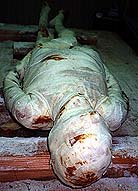 In some ancient Egyptian mummies, this resin appears to have been poured on, covering the entire body. Observations of this tar-like substance is how mummies got their name. Early observers believed this resin to be bitumen (tar), the Persian word for bitumen is moumia. The entire wrapping process took several days and required more than 6 layers or 20 pounds (9 kilograms) of linen. In accordance with ancient practice, a heart amulet was placed over Mumab's heart.
In some ancient Egyptian mummies, this resin appears to have been poured on, covering the entire body. Observations of this tar-like substance is how mummies got their name. Early observers believed this resin to be bitumen (tar), the Persian word for bitumen is moumia. The entire wrapping process took several days and required more than 6 layers or 20 pounds (9 kilograms) of linen. In accordance with ancient practice, a heart amulet was placed over Mumab's heart.
At this point, if Mumab truly were an ancient Egyptian mummy he would be going through burial rituals that dealt with purification and preparing for the afterlife, such as the opening of the mouth ceremony. Mumab's body is not destined for the afterlife. He is now resting in the Museum of Man in San Diego, CA. He will continue to be studied by Ronn Wade, Bob Brier, and scientists of this, and future generations.
